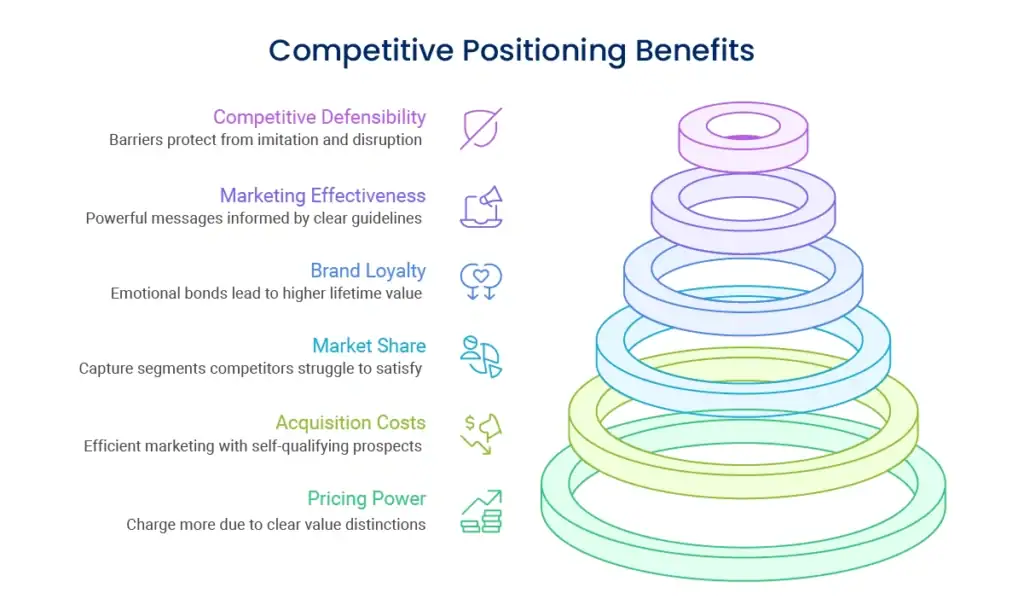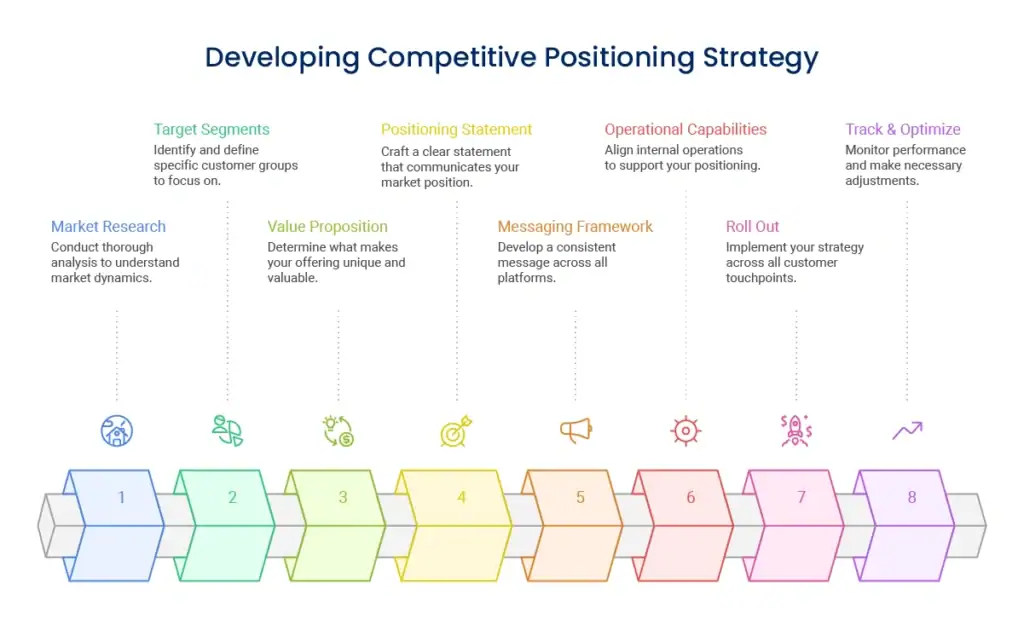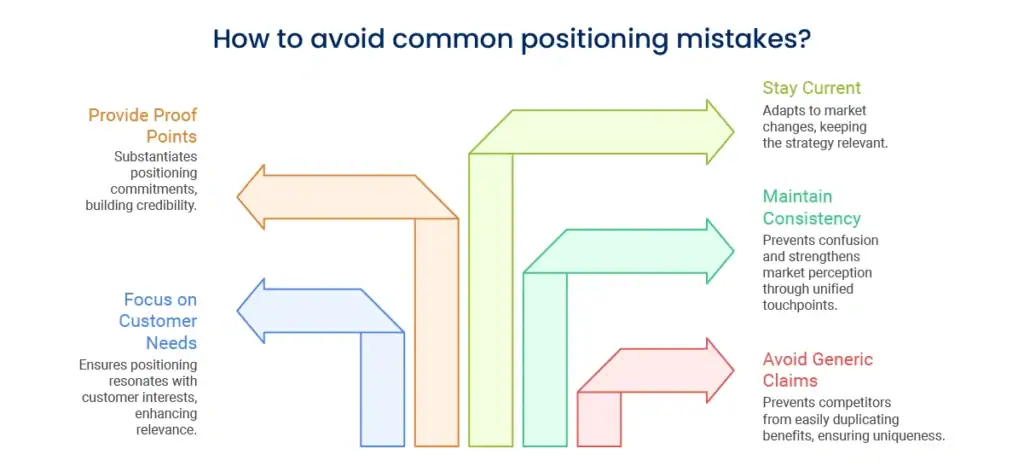Custom Design
Imagine this: You’ve opened up shop with enthusiasm and excellent products, yet your competitors somehow manage to steal your customers. You can’t help but question why prospects prefer them over you, even when you’re providing a better value. This maddening situation occurs when companies don’t have a solid competitive positioning strategy.
Competitive positioning is not merely a matter of being different, but of being strategically different in the ways that matter to your target market. Done well, it turns your business into a preferred choice and creates long-term competitive advantages that fuel sustainable growth.
This authoritative guide will take you through the entire spectrum of competitive positioning strategy, from grasping market dynamics to applying cutting-edge positioning methods that create your distinctive market position and develop long-term competitive strength.

Competitive positioning is the process of strategic positioning in a unique place in the market compared to your competition. It’s how you define and convey what makes your brand, product, or service uniquely valuable to your target customers.
Consider competitive positioning like staking your claim in the customer’s mind. Similar to how physical stores compete for optimal real estate locations, brands compete for mental real estate – the precise associations, benefits, and feelings customers link with your business.
The strategic imperative to see competitive positioning as a business foundation is more than mere differentiation. It requires intensive market intelligence gathering, knowing customer demands that competitors are falling short of, and developing a positioning strategy that’s authentic to your brand yet engages your audience.
Good competitive positioning has a direct impact on your bottom line. It drives pricing power, customer acquisition expenses, brand loyalty, and market share expansion. Businesses that are well-positioned compete on price, have better retention rates of customers, and create enduring competitive barriers to entry around their companies.

Powerful competitive positioning provides quantifiable business results that have a direct effect on your growth path. Here’s why becoming proficient in this strategic discipline is important:

Strongly positioned brands enjoy the ability to charge more because customers see clear value distinctions. This greater pricing flexibility can elevate profit margins by 15-25% over commodity competitors.
With clear positioning of distinctive value, marketing is more focused and efficient. Prospects self-qualify, minimizing wasted advertising expenditure and enhancing conversion ratios.
Clear positioning enables you to capture targeted customer segments that competitors find difficult to satisfy effectively, which leads to durable market share increases.
Consumers form emotional bonds with brands that hold unique positions in their minds, leading to greater lifetime value and lower churn rates.
Each marketing message, campaign, and touchpoint becomes more effective and powerful when informed by clear positioning guidelines.
Good positioning puts up barriers that make it hard for others to imitate your market position, insulating your business from price wars and market disruption.
The brand positioning process then serves as your strategic compass, informing every business decision ranging from product development to customer service standards.

You require in-depth market intelligence before you can write your positioning strategy. This entails creating your competitive landscape map, decoding customer decision-making, and discovering positioning opportunities in the form of gaps.
Begin by carrying out extensive competitor analysis from many different dimensions. Analyze how they message, price, get rated by customers, market, and what their brand personalities are. Check patterns in their positioning and find areas where customer needs are not fully served.
Customer research is the basis for successful positioning. Interview, survey, and conduct focus groups to learn how customers make purchasing decisions in your category. Listen carefully to the vocabulary customers use to explain problems, benefits, and perfect solutions.
Competitive positioning needs to be uniformly implemented in every customer touchpoint. This involves linking your sales process, customer service expectations, product development priorities, and marketing communications to your selected position.
Develop positioning guidelines defining how your distinctive market position will be expressed in various settings. Your web site messaging, sales pitches, onboarding of customers, and even your physical office setting should all reinforce your positioning consistently.
Training becomes essential to effective implementation. All team members who have contact with customers need to know your positioning strategy and how to effectively communicate it in their area of responsibility.
As you move into new markets or introduce new products, your competitive positioning strategy informs tactical choices. You’ll have to decide whether to aggressively counter entrenched competitors or stake out unoccupied market space.
Competitive response strategies enable you to defend your position when competitors seek to copy your strategy. This could be through further differentiation, moving into neighbouring market segments, or reinforcing customer relationships through better service delivery.

Start with disciplined competitive intelligence collection. Develop rich profiles of direct and indirect competitors, their positioning statements, value propositions, pricing strategies, and customer feedback patterns.
Plot customer journey phases and the decision-making factors in each step. Knowing how prospects assess options serves to position your offering at decision points.
Embracing tools such as customer interviews, online reviews analysis, and social media monitoring to collect original customer language describing problems and solutions in your industry.
Focus on individual customer segments where you can gain a competitive edge. Broad targeting water-downs positioning effectiveness and makes differentiation harder.
Develop rich customer personas incorporating demographic data, behavior patterns, pain points, objectives, and buying criteria. Knowing your ideal customers in depth allows more accurate positioning.
Test your target segments by conducting market research and initial customer interactions. Search for segments where disproportionate value is created by your distinctive capabilities.
Examine the overlap between customer requirements, your distinctive strengths, and competitive gaps. Your most compelling positioning occurs where these three intersect.
Inventory your core competencies, resources, and differentiation factors. Think about tangible aspects such as technology, process, and know-how, as well as intangible assets such as brand reputation and firm culture.
Prove various value propositions with target customers to see what best works and generates purchase intent.
Write a concise positioning statement in this format: “For [target customer segment], our [product/service category] is the only one that [unique benefit] because [reason to believe].”
Your positioning statement should be memorable, defendable, and centrally relevant to customer decision-making.
Make sure your positioning statement stands the “so what” test – it should quickly tell customers why they should care and choose you over something else.
Craft key messages that enliven your positioning in all settings and audiences. Make versions for diverse stakeholders such as customers, partners, investors, and employees.
Establish a hierarchy of messages with your central positioning statement at the pinnacle, substantiated by fundamental proof points and concrete benefits for various customer groups.
Develop guidelines for how positioning must be conveyed in multiple formats, from elevator pitches to extensive sales presentations.
Determine if current operations are capable of delivering against your positioning commitments. Define discrepancies between your positioned capability and real service delivery.
Invest in improving areas that underpin your positioning strategy. This may include introducing specialist staff, upgrading technology infrastructure, or re-architecting customer experience processes.
Establish accountability frameworks to ensure your positioning isn’t marketing rhetoric but actual operational fact.
Implement your positioning strategy deliberately across customer touchpoints. Begin with high-impact touchpoints such as website messaging, sales pitches, and critical marketing collateral.
Educate customer-facing teams about your positioning strategy and equip them with tools to communicate it effectively. Role-playing exercises enable teams to rehearse positioning conversations.
Check consistency in implementation and collect feedback from teams regarding positioning issues or customer reactions.
Set benchmarks to measure positioning impact, such as brand recognition, consideration rates, win/loss ratios, and customer acquisition costs.
Conduct regular customer and prospect surveys to gauge positioning clarity and relevance. Monitor shifts in the perceived position of your brand against the competition.
Prepare to adjust your positioning in response to market feedback, competitive reaction, and business growth targets.

Occasionally companies must change their market position based on shifting customer needs, competitive stress, or strategic shifts. Repositioning must be planned carefully to prevent confusing existing customers while inducing new segments.
Effective repositioning begins by communicating clearly why the change is good for customers. Introduce new positioning elements gradually while preserving core brand equity valued by customers.
Keep the strategic brand management strategy in mind when making significant changes to positioning in order to bring consistency across the entire brand touchpoints.
Each product in your portfolio may have a different positioning strategy while holding overall brand consistency. It consists of developing a positioning hierarchy linking individual product positions to your master brand position.
Create positioning maps to illustrate how various products fulfill various customer segments or applications. Make sure every product position supports instead of contradicts your overall competitive strategy.
Competitive positioning that is sustainable involves creating barriers to entry so that others cannot quickly copy your position. This may include creating proprietary skills, establishing strong relationships with customers, or generating network effects.
Emphasize putting pieces in place that get more powerful as time goes by, like brand credibility, customer intelligence insights, or partner ecosystems. These build compound benefits that are hard for others to top.

Refrain from positioning on benefits that competitors can readily duplicate or appropriate, e.g., "quality," "service," or "value." These are too general and unconvincing.
Avoid positioning on what you would like to say instead of what customers are interested in. Successful positioning begins with customer needs and decision-reasons.
Not applying all touchpoints according to your positioning strategy confuses and dilutes market perception. Consistency in all interactions is crucial.
Powerful positioning demands solid proof points that substantiate your position. Create tangible proof points that substantiate your positioning commitments.
The process of strategy development prevents such errors by developing organized methodologies for making positioning choices.
Successful competitive positioning necessitates continuous monitoring and optimisation. Brand awareness measures, studies of customer perception, win/loss analysis of competition, and market share monitoring are some of the key performance indicators.
Customer feedback is priceless when it comes to positioning efficacy. Ongoing surveys can indicate whether your targeted position aligns with customers’ perceptions and where adjustments are needed.
Competitive monitoring enables you to recognize how competitors are reacting to your positioning and if market dynamics necessitate strategic change. Such intelligence guides positioning evolution decisions.

Strong competitive positioning gives resilience in the case of market disruption or competitive attack. Brands with definite, differentiated positions fare better in sustaining customer loyalty through difficult times.
Create contingency plans for different scenarios that could jeopardize your market standing. These are competitive reaction, market decline, or reputation issues that would affect customer attitudes.
Crisis communications will support your brand positioning and speak to the particular issues. Consistent messages in times of trouble preserve equity and build customer trust.
Effective competitive positioning calls for alignment across the entire organisation around your strategic direction. This involves making sure each department knows how their efforts assist your market position.
Cultural integration consists of integrating positioning principles into the decisions to hire, how to evaluate performance, and strategic planning procedures. Positioning that is integrated into company culture makes implementation automatic and consistent.
Ongoing internal communication regarding positioning strategy keeps everyone in sync as your organization develops and expands. Educate and inspire teams with customer feedback, competitive intelligence, and positioning success stories.
Developing solid competitive positioning usually takes 6-18 months based on your market dynamics, marketing spend, and consistency of execution. But early market traction often can be realized in as little as 3-6 months after deploying a well-executed position effort.
The time frame differs considerably depending on criteria such as market maturity, competitiveness, and your organisation’s capacity to deliver positioning promises across all touch points consistently.
Small businesses can frequently enjoy positioning benefits compared to large competitors, such as increased agility, ability to deliver personalized services, and the capacity to serve distinctive segments better. The trick is finding specific customer segments where your distinctive capabilities deliver disproportionate value.
Concentrate on market positioning strategy building on your advantages instead of attempting to match large competitors in every respect. Frequently, being clearly different works better than being incrementally better.
ROI on positioning can be gauged through several measurements such as better conversion rates, enhanced average selling prices, lower customer acquisition costs, and higher customer lifetime values. Monitor these measures pre- and post-positioning implementation to determine impact.
Investments in brand positioning strategy usually translate into returns in the form of enhanced marketing effectiveness, increased pricing leverage, and greater competitive protection, although some advantages may only emerge over time.
Competitive positioning mastery turns your company from commodity player to market leader with durable competitive advantages. Strategic imperative knowledge of competitive positioning as business foundation allows you to maintain premium prices, attract best customers more effectively, and create enduring defensibility in the market.
It means having systematic execution throughout your whole organisation, from the very first market research to continuous optimisation depending on customer input and competitor insight. When positioning is ingrained in your company culture and continuously delivered through all touchpoints, it builds compound advantages that are ever tougher for competitors to imitate.
The investment in competitive positioning development and execution yields dividends in terms of better business performance, improved customer relationships, and long-term growth opportunities. Begin with extensive market research, develop positioning that genuinely represents your distinct capabilities, and ensure consistent execution across all customer touchpoints.
Your competitive positioning strategy becomes the guiding light for all marketing decisions, product development initiatives, and customer experience investments. Get the most out of it by making sure it is rooted in authentic customer insights, underpinned by operational strengths, and defended by ongoing innovation and market intelligence.
Effective competitive positioning development and execution demand rich market understanding, strategic consideration, and methodical application throughout your organization. If you want to improve your market standing or are having positioning clarity issues, our brand strategy professionals can assist you in going through this important process and attaining lasting competitive benefits.

Enter your email to get instant access